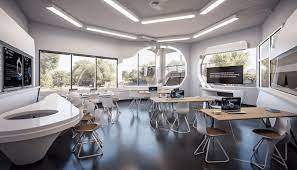Introduction:
The introduction of 3D modeling technology has brought about a revolutionary change in the fields of interior design and furniture manufacture. Furniture 3D modeling has become a potent technology that offers a number of benefits to designers, producers, and customers alike, in addition to streamlining the design process. This essay will examine the many advantages of 3D modeling furniture and how it affects our understanding, production, and perception of furniture design.
1. Visual Realism:
Designers may produce incredibly comprehensive and realistic virtual representations of their concepts with furniture thanks to 3D modeling. Beyond simple sketches and two-dimensional drawings, this level of visual realism offers a more accurate glimpse of how the furniture will seem in actual settings. In order to create the ideal look, designers can play around with different materials, textures, and finishes. This allows clients to see the finished product before it is produced.
2. Enhanced Design Process:
Design is an iterative process that frequently requires numerous changes and modifications. Designers can rapidly see the effects of changes, experiment with alternative design variations, and readily adjust elements with 3D modeling. This quickens the design process and makes it possible for designers to refine their ideas more precisely and quickly.
3. Cost and Time Efficiency:
Conventional prototyping can be expensive and time-consuming. Due to the ability of designers and manufacturers to extensively examine and develop designs in the virtual realm, furniture 3D modeling greatly eliminates the requirement for actual prototypes. This reduces the time needed to take a furniture design from concept to manufacturing and lowers production costs.
4. Customization and Personalization:
Furniture design can be more customized and personalized thanks to 3D modeling. Designers can readily experiment with different arrangements, change proportions, and customize parts to match specific client preferences. This degree of adaptability makes it possible to create custom furniture that precisely suits each person’s preferences and needs.
5. Collaboration and Communication:
3D models of furniture are useful for communicating with clients, manufacturers, and designers. All stakeholders are guaranteed to have a clear understanding of the design due to the visual clarity of 3D representations, which helps to eliminate misconceptions. This makes teamwork easier and communication better across the whole design and production process.
6. Sustainability and Material Optimization:
3D modeling enables designers to investigate environmentally friendly materials and maximize resource utilization in the age of sustainable design. Through the process of simulating material behavior and environmental impact, designers can make well-informed decisions that are consistent with sustainable design principles. This aids in the development of furniture designs that consider the surroundings.
7. Market Testing and Pre-visualization:
3D models of furniture are quite helpful for pre-visualization and market testing. Before investing in actual production, designers and manufacturers can test the market or show off new ideas to prospective customers using digital prototypes. By using a strategic strategy, risks decrease and the end products are guaranteed to meet market demands.
8. Augmented Reality (AR) and Virtual Reality (VR) Integration:
Technological developments have made it easier to incorporate 3D models of furniture into augmented and virtual reality experiences. With the help of this immersive method, clients may virtually arrange furniture in their own rooms to get a realistic idea of how it will fit and appear. This facilitates decision-making and provides customers with a distinctive and interesting shopping experience.
Conclusion:
Unquestionably, furniture 3D modeling has completely changed how designers imagine, produce, and showcase their designs. The benefits of 3D modeling are widespread in the furniture design and production ecosystem, ranging from improved visual realism and efficient design processes to cost effectiveness and sustainable practices. As technology develops, 3D modeling will continue to play a critical role in furniture design, opening up new avenues for efficiency, creativity, and customisation in the field of interior design.

As the editor of the blog, She curate insightful content that sparks curiosity and fosters learning. With a passion for storytelling and a keen eye for detail, she strive to bring diverse perspectives and engaging narratives to readers, ensuring every piece informs, inspires, and enriches.










